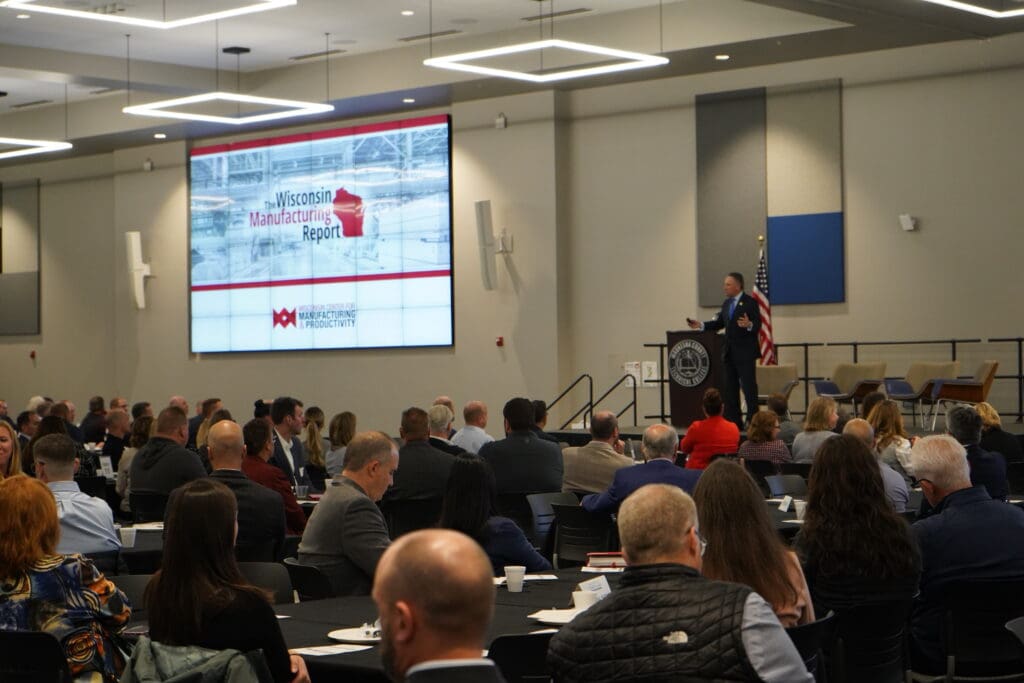
For more than a decade, the Alliance’s annual Manufacturing Voices program has provided the opportunity for industry leaders to spotlight manufacturing. This year was no exception as business leaders came together at Waukesha County Technical College (WCTC) to discuss challenges and opportunities facing the manufacturing sector.
This year’s program included a keynote presentation from Wisconsin Center for Manufacturing & Productivity’s Executive Director & CEO Buckley Brinkman. Brinkman shared highlights from the 2024 Wisconsin Manufacturing Report™ which gauges Wisconsin manufacturing executives’ perceptions of the state of their business and outlook on manufacturing to identify and explore key issues impacting their companies and employees.
Conclusions From the Data
Once again, workforce topped manufacturers’ concerns in the 2024 report. Those concerns catalyzed new investments – both in technology and employee success – and triggered worries about future inflation and competitiveness. Manufacturers largely solved their supply chain issues proving their resilience and ability to recover from crisis situations. Softer demand spurred manufacturers to pursue growth more aggressively, investing in marketing and other initiatives to find new customers.
Labor Pains
The chronic labor shortage pushed workforce issues to the top of the concern list once again. More manufacturers realize they will face a worker shortage for the foreseeable future and are investing accordingly. More flexibility and a willingness to try more of an “all-the-above” approach to attraction and retention show that creativity is a key element in addressing workforce issues. Also, companies increased their investments building employee capabilities and engagement in their businesses.
Economy…meh!
Workforce also drove discussions about the economy as manufacturers believed the overall economy was stuck in neutral and showed serious concern about wage and benefit inflation – particularly health care costs. Concerns about inflation in the other factors of production were muted and most manufacturers thought their business would improve in 2025.
Filling the Factory
The slowdown in the overall economy left many manufacturers with open production capacity. This trend started in last year’s report and intensified this year. Manufacturers have the flexibility to accommodate new customers and are taking action to fill the holes in their schedules. Surprisingly, the most successful tactic to secure those new customers is through word-of-mouth – especially for smaller companies.
Technology Push
Manufacturers continue to turn to automation and other technologies to improve their productivity and maximize their ability to grow. This technology adoption improves competitiveness, eliminates undesirable jobs, and enables employees to contribute in more value-added positions. AI adoption also surged during the year as manufacturers find low-cost, low-risk ways to experiment with this new technology. More technology means more exposure to cybercrime and more manufacturers are taking aggressive precautions to address the threat.
Moderated by Wisconsin Manufacturing Extension Partnership’s Executive Director & CEO Chris Baichoo, the Alliance’s program concluded with an engaging panel of manufacturing executives discussing workforce, company culture, economic indicators, and more. Panelists included Co-President of Ace Precision Sheri Eubanks, President of Wenthe-Davidson, Rob Ewing, and President & CEO of Sussex IM Megan Tzanoukakis.
With the program hosted during Manufacturing Month, the Alliance applauded the work of the manufacturing sector which supplies 1 in 5 jobs in Wisconsin.
Share on Social Media
Recent News
Sign up for newsletter updates
